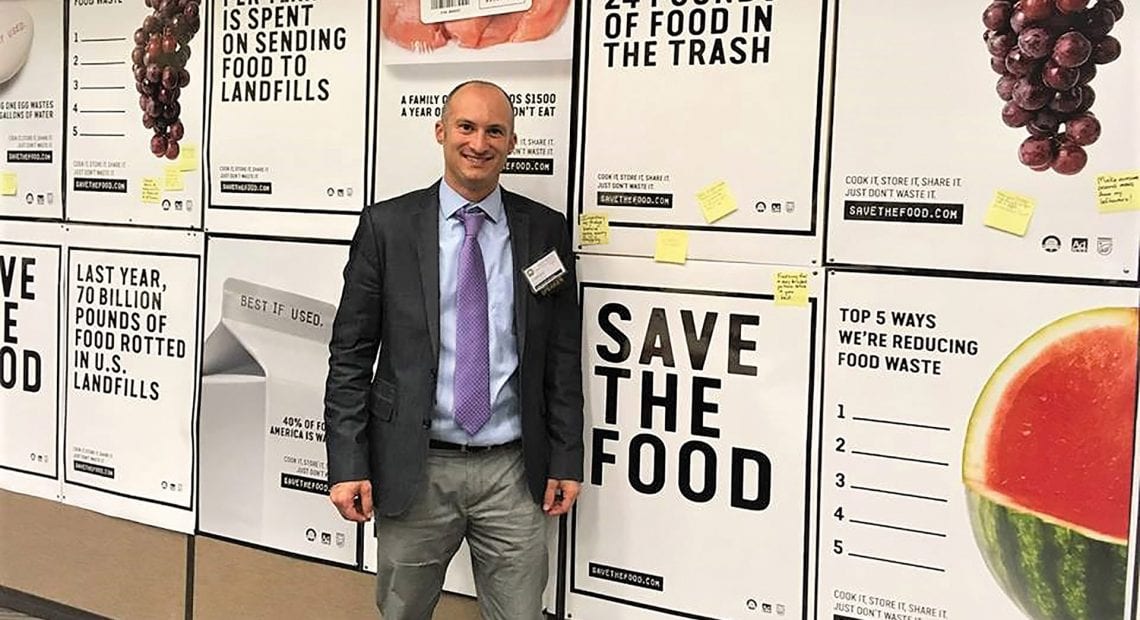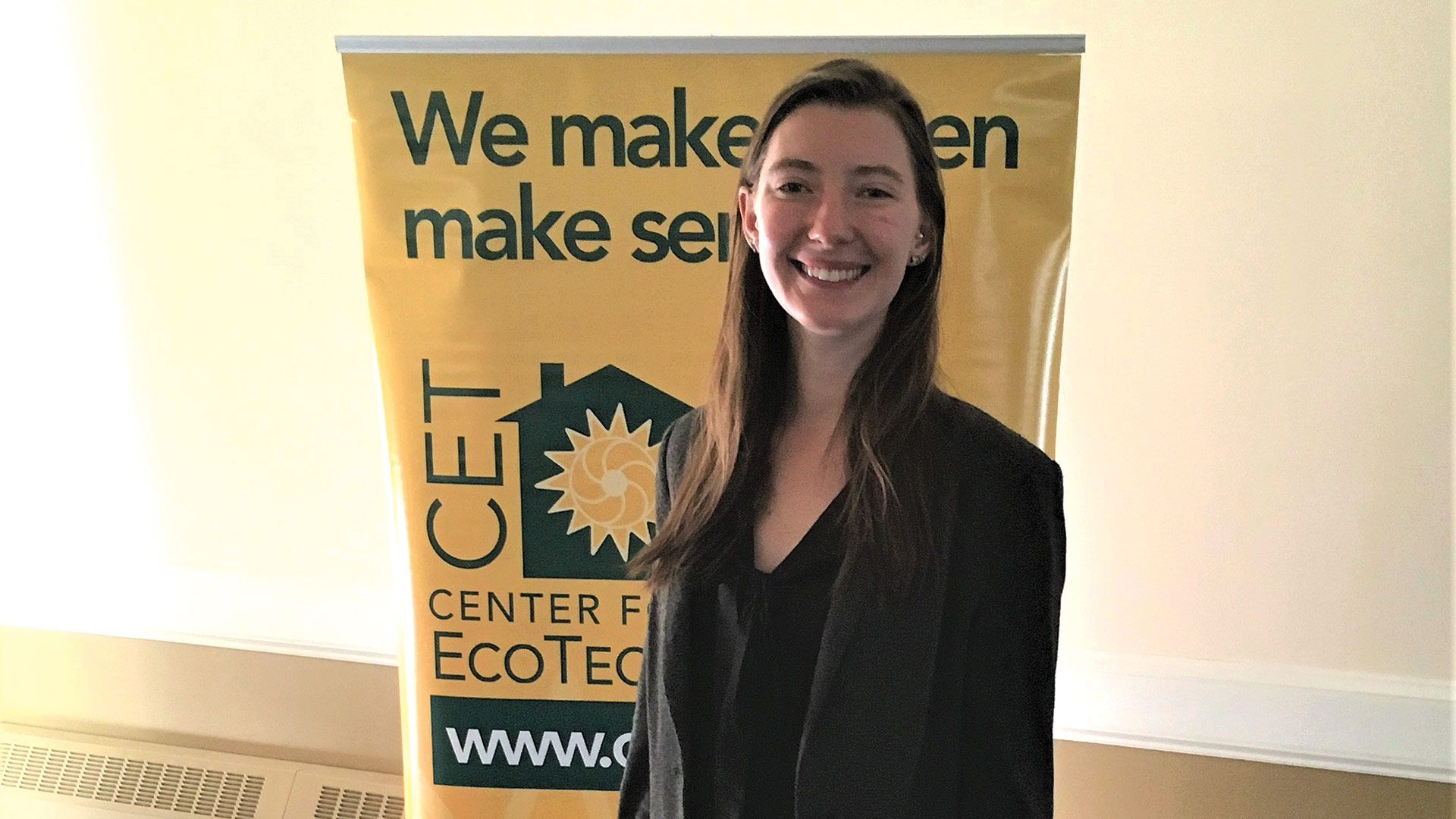
A New Report Details Impact of Food-waste Reduction Efforts
Bans and Beyond

Coryanne Mansell says CET understands how to balance conservation issues (like food-waste reduction)with business needs.
Ask a random person what percentage of food goes to waste. Maybe they’ll say 10% or 20% — some might guess a little more. But few would surmise the actual figure.
“Food waste is a nationally and even globally pervasive issue,” said Lorenzo Macaluso, director of Client Services at the Center for EcoTechnology (CET) in Northampton. “There have been a number of studies on this, all of which find that somewhere in the ballpark of 40% of all food produced is never actually consumed. There is loss at every step of the way along the chain. From a cost perspective, from an environmental perspective, from a resources perspective — basically, by every measure — it’s very significant.”
Massachusetts is one of only six states — five of them clustered in the Northeast, the other being California — and seven metro areas that have implemented organic waste bans on some level. And CET has helped area businesses develop strategies to reduce food waste, so a recent partnership with the Harvard Law School Food Law and Policy Clinic (FLPC) — specifically, a ‘toolkit’ on organic waste bans and their potential to reduce food waste and strengthen local economies — made sense.
“Somewhere in the ballpark of 40% of all food produced is never actually consumed. There is loss at every step of the way along the chain.”
“Massachusetts in general has been a national leader on addressing this issue head-on, through a number of strategies to help keep food from the trash,” Macaluso told BusinessWest. “We’re focused on helping businesses implement those strategies because we have a long, rich history of doing that work. Harvard Law is great at analyzing policies with a legal lens, and we have the practical side, how those policies are actually playing out in real life.”
Food waste in the U.S. amounts to some $218 billion each year spent on food that is never eaten, according to the toolkit, which is basically a lengthy report (titled “Bans and Beyond”) that examines the issue, what those six states and seven cities have implemented, the challenges they’ve faced, and the economic impact of those policies.
As for the core issue, most wasted food ends up in landfills, where it produces greenhouse gases and contributes to states and localities running out of landfill capacity. State and local bans limit the amount of organic waste, including food waste, that businesses and individuals can dispose of in landfills — thus driving more sustainable practices, such as food-waste prevention, food donation, and sending food scraps to animal-feed operations or composting or anaerobic-digestion (AD) facilities.
“Food waste takes up space in landfills, contributes to climate change, and is a drain on the economy,” said Emily Broad Leib, director of FLPC. “Organic waste bans are one of the best tools we have seen that states and localities can use to transform business practices and drive the development of food-waste recycling infrastructure.”

While much work remains, Lorenzo Macaluso says the Bay State has been a national leader on the food-waste issue.
The toolkit walks readers through factors to consider in pursuing similar policies in their own state or locality. It also explores nine other categories of policies and programs — such as permitting and zoning regulations for organics-recycling facilities, grants to support food-waste reduction projects, and policies to create markets for biogas and compost — that can enhance the impact of an organic waste ban or advance food waste reduction and diversion independently.
“Over the years, we’ve seen firsthand how waste bans and the other policies and programs discussed in the toolkit can drive innovation and significantly reduce wasted food,” said John Majercak, president of CET. “The resulting impact is a big win for communities, regional economies, and the environment.”
The environmental impact is significant. According to the report, 21% of the U.S. freshwater supply and 300 million barrels of oil are used to produce food that goes to waste. And in 2012, more than 20% of municipal solid waste disposed of was food waste — especially noteworthy at a time when cities and states are running out of space to pile trash. Furthermore, organic materials in landfills decompose and release methane, a greenhouse gas that contributes to climate change. Food waste is responsible for at least 11% of methane emissions generated from landfills, an amount equivalent to the emissions of about 3.4 million vehicles.
“We’ve seen firsthand how waste bans and the other policies and programs discussed in the toolkit can drive innovation and significantly reduce wasted food.”
“We partnered with the Harvard Food Law and Policy Clinic to develop this toolkit because we have boots-on-the-ground experience with businesses to implement food-waste diversion programs, as well as understanding market needs,” said Coryanne Mansell, Strategic Services representative at CET, adding that individual businesses, at least locally, increasingly understand the problem, especially after hearing the 40% statistic. “That’s a huge impact on the environment.”
“When I mention that number,” Macaluso added, “100% of the people are really surprised when they first hear it.”
The Massachusetts Model
Unlike other states with organic waste bans, Massachusetts established its disposal ban through regulation rather than legislation. In 2014, the Commonwealth’s Department of Environmental Protection (DEP) amended regulations on solid-waste disposal by adding ‘commercial organic material’ to a list of several materials already barred from entering solid-waste disposal streams.
The ban applies only to commercial and institutional food-waste generators (not households) that dispose of at least one ton of those materials in waste per week, and and only for weeks during which they surpass that one-ton threshold. Temporary exemptions from the ban may be issued if the waste is contaminated or unacceptable for composting or other use, and the entity takes steps to prevent the contamination from recurring, or if a waste generator’s usual composting or other processing service declines the waste and the generator cannot find an alternative within a reasonable time.
Food-scrap generators may comply by reducing their waste production below the one-ton-per-week threshold, donating surplus food, processing food scraps on site, or sending food scraps to an animal-feed, composting, or AD facility.
To aid in compliance, Massachusetts offers several options for funding organics-processing operations. The DEP also partners with BDC Capital to administer the Massachusetts Recycling Loan Fund, which provides loans to eligible businesses, including recycling and composting companies. The fund offers preferred terms for composting, AD, and other food-waste processing facilities. Another funding source for renewable-energy projects is the Massachusetts Clean Energy Center, a quasi-public agency that provides grants and technical assistance for clean-energy innovators.
Due to the efforts of organizations like RecyclingWorks, food-rescue organizations, and state and local agencies, the amount of food donated or rescued in Massachusetts has increased at least 22% since the organic-waste ban went into effect, from 21,300 tons in 2014 to 25,900 tons in 2017.
“We’ve had great results,” Macaluso said. “An economic-impact study was conducted, showing increased investment and job creation and large diversion of food-waste tonnage … it’s been quite effective.”
That economic impact has been an underreported part of the story. The Massachusetts DEP contracted with ICF, a management-consulting company, in 2016 to conduct an analysis of the impacts of Massachusetts’ commercial food-waste ban and broader trends in the state’s organic waste industry. To accomplish this, they developed a survey targeting three primary sectors: organic waste haulers, processors and composters, and food-rescue and recovery organizations.
The study found that the three sectors together supported more than 900 total jobs in 2016, and that all three sectors reported significant growth in employment in recent years, with more than 500 jobs added between 2010 and 2016. In 2016, the jobs supported by all three sectors combined generated more than $46 million in labor income, and the industries contributed nearly $77 million to the gross state product and produced almost $175 million in industry activity. Finally, the organic-waste industry contributed more than $5 million in state and local tax revenue in 2016. The analysis projected that growth would continue in 2017 in beyond.
“When we evaluate the impact of these waste bans,” Mansell told BusinessWest, “we see they can create job growth, help feed more hungry people, and, of course, increase capacity at existing landfills.”
All Aboard?
The toolkit lays out this data in detail not just for Massachusetts, but for New York, Vermont, Connecticut, Rhode Island, California, and the seven metro areas (New York City; Seattle; San Francisco; Portland, Ore.; Austin, Texas; Boulder, Colo.; and Hennepin County, Minn.). The hope now, among those who prepared the toolkit, is that other states will consider these case studies and be part of a national effort to lower that daunting 40% statistic.
CET has been promoting waste-reduction efforts on the local level for a long time, Mansell said. “We help people understand what the regulatory requirements are, but we also come at it from a company perspective, helping them implement a program that’s best suited for their needs, really meeting those businesses where they are. And we’ve seen some pretty positive experiences because companies are seeing the financial savings and seeing the social and environmental opportunities from these programs as well.”
For states wondering if a food-waste ban would work, she added, “we do hope this toolkit provides a roadmap.”
The report makes clear that it’s not an easy decision. A state or locality must determine whether it has, or plans to develop, the necessary infrastructure to process the organic waste that a ban would divert from landfills, from composting and AD facilities that accept food scraps to collection services and food-rescue organizations.
A state or city must also determine whether implementing an organic waste ban would be politically and financially feasible, the report notes. “In the absence of a plan to develop sufficient infrastructure, or without political support or financial resources, a state or locality may wish to focus on a non-binding strategy such as a zero-waste plan or waste-management strategy, or on more targeted policies to support infrastructure development, before pursuing an enforceable organic waste ban or mandate.”
So change doesn’t necessarily happen overnight. But Macaluso says these kinds of changes are worth pursuing.
“We understand business. We understand things have to make business sense,” he said. “But we do feel like this is a win all around.”
Joseph Bednar can be reached at [email protected]





